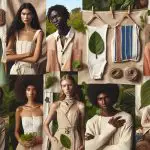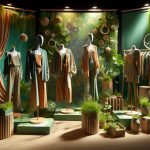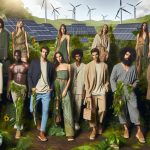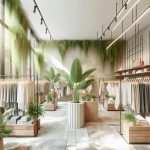Are you curious about the designers who are leading the way in sustainable fashion? Look no further! In this article, we will introduce you to seven incredible designers who are championing fabric made from plants.
From Stella McCartney’s pioneering efforts in sustainable fashion to Patagonia’s use of recycled polyester for outdoor gear, these designers are revolutionizing the industry.
Get ready to be inspired by their stylish and eco-friendly designs!
Table of Contents
Stella McCartney: A Pioneer in Sustainable Fashion
Stella McCartney leads the way as a pioneer in sustainable fashion, utilizing fabric derived from plants. One of the standout features of McCartney’s sustainable approach is her commitment to vegan leather alternatives. Understanding the environmental impact of traditional leather production, McCartney has chosen to use innovative materials such as mushroom-based leather and vegetable-derived eco-suede. These alternatives not only mimic the look and feel of real leather but also reduce the need for animal products in the fashion industry.
In addition to her vegan leather alternatives, McCartney also incorporates sustainable practices throughout her supply chain. She prioritizes the use of organic and recycled materials, reducing the overall environmental footprint of her designs. McCartney also works closely with her suppliers to ensure fair labor practices and ethical sourcing. By focusing on transparency and traceability, she aims to create a more sustainable and responsible fashion industry.
McCartney’s commitment to sustainability extends beyond her materials and supply chain. She actively promotes circularity and encourages customers to repair and recycle their clothing. Through initiatives like the ‘Care for Life’ program, McCartney offers repair services for her designs, prolonging their lifespan and reducing waste. By championing fabric from plants and adopting sustainable practices, Stella McCartney is setting a high standard for the fashion industry and inspiring others to follow in her footsteps.
Mara Hoffman: Embracing Hemp for Eco-Friendly Designs
To champion eco-friendly designs, you can look to Mara Hoffman, who embraces hemp as a fabric derived from plants. Hemp’s versatility makes it an ideal choice for sustainable fashion, and Hoffman has incorporated it into her designs as part of her sustainability efforts.
Hemp is a natural fiber that’s known for its durability and strength. It requires less water and pesticides compared to other crops, making it a more sustainable option. Hoffman recognizes the environmental benefits of using hemp in her designs and has been a vocal advocate for its use in the fashion industry. By incorporating hemp into her collections, she showcases its versatility and proves that sustainable fashion can be stylish and trendy.
Hoffman’s sustainability efforts extend beyond just using hemp. She also focuses on using organic and recycled materials in her designs, minimizing waste, and supporting ethical production practices. Through her commitment to sustainability and the use of hemp, Mara Hoffman is leading the way in creating eco-friendly designs that are both fashionable and environmentally conscious.
Eileen Fisher: Leading the Way With Organic Cotton
Eileen Fisher continues the trend of championing fabric from plants by leading the way with her use of organic cotton. This sustainable practice not only benefits the environment but also promotes healthier living conditions for farmers and consumers alike. Here are three reasons why Eileen Fisher’s commitment to organic cotton is worth celebrating:
-
Improved soil health: Organic cotton is grown without the use of harmful chemicals and pesticides, allowing the soil to retain its fertility and biodiversity. This not only protects the ecosystem but also ensures that future generations can continue to cultivate the land.
-
Reduced water consumption: Conventional cotton farming is notorious for its high water usage. In contrast, organic cotton requires significantly less water, conserving this precious resource and mitigating the impact on water scarcity.
-
Safer working conditions: By choosing organic cotton, Eileen Fisher supports fair trade practices and helps protect the health and well-being of cotton farmers. Organic farming methods eliminate exposure to toxic chemicals, reducing the risk of respiratory problems and other health issues.
Eileen Fisher’s sustainable practices go beyond just using organic cotton. She also emphasizes transparent supply chains, fair labor practices, and recycling initiatives. By choosing Eileen Fisher’s clothing, you aren’t only making a fashion statement but also supporting a brand that prioritizes ethical and eco-friendly practices.
Reformation: Revolutionizing Fashion With Tencel
When it comes to revolutionizing fashion with fabric from plants, one designer stands out: Reformation. Their impact on the fashion industry is undeniable, and their use of Tencel has played a significant role in their success. Tencel is a sustainable fabric made from eucalyptus trees, known for its softness, breathability, and environmental benefits. Reformation recognizes the importance of using sustainable materials and has embraced Tencel as a core component of their designs.
The benefits of Tencel are numerous. Firstly, it’s produced using a closed-loop process, meaning that the chemicals used in its production are recycled and reused, making it more eco-friendly than traditional fabrics. Secondly, Tencel has excellent moisture-wicking properties, making it ideal for activewear and summer clothing. It also has a smooth and luxurious feel, providing comfort and style simultaneously.
Reformation’s use of Tencel has had a significant impact on the fashion industry. By choosing sustainable materials, they’ve set a precedent for other designers to follow. Their commitment to environmental responsibility hasn’t only attracted environmentally-conscious consumers but has also challenged the industry as a whole to adopt more sustainable practices.
Amour Vert: Stylish and Sustainable Designs With Modal
Amour Vert is a brand that combines style and sustainability by using modal, a fabric known for its eco-friendly properties. With Amour Vert, you can have fashion-forward designs that are also mindful of the environment.
Modal’s Eco-Friendly Properties
You can discover the eco-friendly properties of modal, a fabric made from plants, through stylish and sustainable designs by Amour Vert. Modal’s benefits for the environment make it a top choice for conscious consumers.
Here are some reasons why modal is eco-friendly:
-
Sustainable sourcing: Modal is made from beech trees, which are fast-growing and require less water and pesticides compared to cotton.
-
Reduced waste: The production process of modal generates less waste and uses fewer chemicals, making it a greener alternative.
-
Versatile fashion: Modal is known for its softness, breathability, and ability to drape beautifully. It can be used to create various styles, from casual tees to elegant dresses, allowing you to look fashionable while being eco-conscious.
Amour Vert showcases the potential of modal by creating fashionable and sustainable designs that prioritize the environment without compromising style.
Amour Vert’s Fashion-Forward Approach
One of the best designers championing fabric from plants is Amour Vert, known for their fashion-forward approach and stylish, sustainable designs featuring modal.
Amour Vert’s fashion-forward sustainability is evident in their eco-friendly fabric choices. They prioritize using modal, a fabric made from renewable beechwood pulp.
Modal isn’t only soft and comfortable to wear, but it also has a low environmental impact. The production process of modal requires less energy and water compared to other fabrics, making it a more sustainable option.
Amour Vert’s commitment to eco-friendly fabric choices reflects their dedication to creating fashion that’s both stylish and sustainable. By incorporating modal into their designs, they’re paving the way for a more environmentally conscious fashion industry.
Patagonia: Utilizing Recycled Polyester for Outdoor Gear
Now let’s talk about Patagonia and their innovative approach to using recycled polyester for their outdoor gear.
Have you ever wondered how sustainable polyester production can be achieved? And what about the environmental impact of polyester?
These are important points to consider when discussing Patagonia’s use of recycled polyester in their products.
Sustainable Polyester Production
Patagonia demonstrates their commitment to sustainable polyester production by utilizing recycled polyester for their outdoor gear. They’ve found innovative polyester manufacturing techniques that not only reduce waste but also minimize the environmental impact. Here are three reasons why Patagonia’s sustainable polyester production is making a difference:
-
Reduced carbon footprint: By using recycled polyester, Patagonia helps decrease the demand for new polyester production, which requires significant energy and emits greenhouse gases.
-
Resource conservation: By reusing polyester, Patagonia reduces the need for virgin materials, conserving natural resources like petroleum and water.
-
Waste reduction: By recycling polyester, Patagonia helps divert plastic waste from landfills and oceans, contributing to a cleaner and healthier environment.
Through their commitment to sustainable polyester alternatives and innovative manufacturing techniques, Patagonia sets an example for the fashion industry, proving that outdoor gear production can be environmentally responsible.
Environmental Impact of Polyester?
When considering the environmental impact of polyester, it’s important to examine how utilizing recycled polyester for outdoor gear can mitigate the negative effects.
Polyester, a synthetic fiber derived from petroleum, is widely used in the textile industry due to its versatility and affordability. However, the production of polyester has significant environmental drawbacks. It requires the extraction of non-renewable resources and emits harmful greenhouse gases during manufacturing.
This is where recycled polyester comes in as a viable alternative. By using recycled polyester, companies like Patagonia can reduce their reliance on virgin polyester and divert waste from landfills. This approach has several advantages. It conserves energy, reduces greenhouse gas emissions, and decreases water consumption.
Additionally, it helps to minimize the demand for new polyester production, thereby reducing the negative environmental impact associated with its manufacturing process. By choosing recycled polyester for outdoor gear, consumers can contribute to a more sustainable fashion industry.
Elizabeth Suzann: Creating Timeless Pieces With Linen
Elizabeth Suzann showcases the versatility and elegance of linen through her creation of timeless pieces. With a focus on timeless style and linen’s versatility, Elizabeth Suzann has become a champion of sustainable fashion.
Here’s why her pieces evoke such an emotional response:
-
Effortless Sophistication: Elizabeth Suzann’s linen creations exude an effortless sophistication that’s both modern and timeless. Whether it’s a simple linen dress or a tailored linen blazer, her designs exude a sense of understated elegance that never goes out of style.
-
Comfort and Breathability: Linen is known for its exceptional breathability and comfort, making it the perfect choice for warm weather. Elizabeth Suzann’s linen pieces are lightweight, allowing for maximum comfort while still maintaining a polished and put-together look.
-
Versatility for Every Occasion: From casual outings to formal events, Elizabeth Suzann’s linen pieces are versatile enough to be dressed up or down. Whether you’re going for a relaxed weekend look or attending a special occasion, her timeless designs can effortlessly transition from day to night.
Elizabeth Suzann’s commitment to creating timeless pieces with linen not only showcases the fabric’s versatility but also emphasizes the importance of sustainable and ethical fashion choices. By investing in her designs, you’re not just buying a piece of clothing, but also supporting a movement towards a more conscious and stylish future.
Frequently Asked Questions
How Did These Designers Become Interested in Using Fabric From Plants in Their Designs?
You became interested in using fabric from plants in your designs because of your motivation to create sustainable and eco-friendly fashion. Influences and inspirations from nature and the desire to make a positive impact drove your decision.
What Are Some of the Challenges That These Designers Face When Working With Fabric From Plants?
When working with fabric from plants, you face challenges like sourcing constraints and limited durability. However, using plant-based fabrics in fashion is beneficial because they are eco-friendly and offer breathable fabrics.
Are There Any Specific Benefits or Advantages to Using Fabric From Plants in Fashion?
Using fabric from plants in fashion offers numerous benefits and promotes sustainability. It not only reduces the environmental impact of the fashion industry but also provides a natural and biodegradable alternative to synthetic materials.
How Do These Designers Ensure That Their Fabric From Plants Is Sustainably Sourced and Produced?
To ensure sustainability practices, designers championing fabric from plants carefully select and source their materials. They prioritize production methods that minimize environmental impact, like using organic farming techniques and implementing closed-loop systems for processing and recycling waste.
Can You Provide Examples of Specific Garments or Designs That These Designers Have Created Using Fabric From Plants?
You’ll find specific garments or designs using fabric from plants like a dress made from pineapple fiber by Carmen Hijosa and a suit made from hemp fabric by Stella McCartney.
- How Does Ring Spun Cotton Affect Garment Fit and Shape Retention? - August 13, 2024
- What Are the Challenges in Producing Ring Spun Cotton? - August 13, 2024
- Is Ring Spun Cotton Suitable for Plus-Size Clothing? - August 13, 2024






